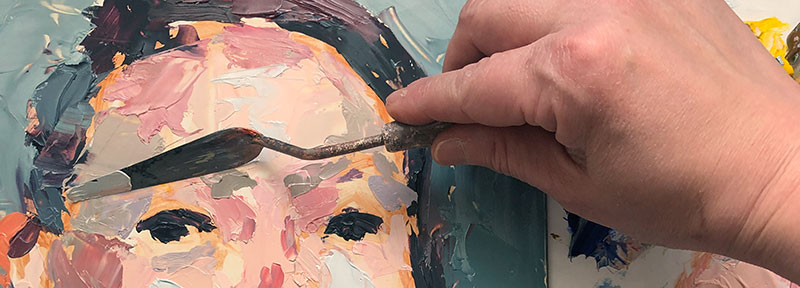See a painting demo of how to mix flesh tones using water mixable oil paints and a palette knife.
- 44 second short (summary)
- 1 min. short (flesh tones)
- 1 min. short (red for flesh tones)
- 1 min. short (oil vs. water mixable)
- 1 min. short (universal pigment #s)
- Part 1 (1 hour 43 minutes)
- Part 2 (2 hours)
Using exclusively a palette knife is an effective way to focus entirely on the color mixing process by removing the distraction of needing to address brush technique at the same time.

Painting a self-portrait from life, you’ll see how to observe colors in the skin and balance out hue, saturation, value, and warm/cool colors. Demo by Art Prof Clara Lieu.
Examples
Jen K., Jen Noelle, Johanna, Ashley Tanelle
Video Walkthrough
- Palette knife paintings simplify the process, it’s just one tool.
- The shape and size of a palette knife is a very personal choice.
- Try out many different palette knives to figure out the ones you like.
- The palette knife can be a very awkward tool, it takes time.
- Palette knives are most effective when you use a lot of physical pressure, a lot of people don’t.
- Not using brushes makes it possible to really concentrate on the mixing.
- Mixing colors is time consuming!
- Don’t be frustrated if you are mixing a ton before starting with a brush.
- Artificial light has a warm tint, natural light has a cool tint.
- Look at the color in relation to the colors next to it to determine how to adjust your mixtures.
- Look at the color of your forehead compared to the color of your nose.
- A lot of color mixing is trial and error.
- After you mix a color, put a little swatch on your painting to see how it relates to the other colors before adding a ton of it to the painting.
- This exercise is not about creating a self-portrait that looks like you, you’re using yourself in order to be able to observe the colors in real life.
- Using a very limited palette will get you to mix more, and you can incrementally add more colors.
- Don’t just paint the face, be sure to establish the neck, hair, and shoulders.
- Brushes can be distracting when you’re painting, you’re a lot less likely to mix as aggressively.
- 3/4 view of a portrait tends to look more volumetric than straight on views or profiles.
- Use a panel, being a rigid board you’ll be able to provide more physical with the palette knife.
- To truly see color, you need the experience of seeing colors in real life, especially flesh tones.
- Colors don’t translate well in photos, you’ll miss all the subtleties.
- If you aim to create accurate colors from what you see, it will likely be too dull, so exaggerate the colors.
- Training your eye to SEE color will ultimately be the most efficient.

Prof Lieu’s Tips

This palette knife painting exercise takes way longer than you think it will, so you won’t see anything that feels even remotely concrete until you hit the 4th or so layer of paint.

What I would recommend is add the painter a bit thicker, and not to be afraid to show your paint strokes. Try to avoid blending the paint and making it smooth, that’s pretty much impossible with just the palette knife.
Your palette knife painting will feel really awkward and chunky, that’s part of the experience of this prompt!
Art Supplies
We want to share your progress!

- Did you do this lesson?
- Submit to have your work to be posted here on this page or mentioned in a live stream.
As a free educational source, Art Prof uses Amazon affiliate links (found in this page) to help pay the bills. This means, Art Prof earns from qualifying purchases.
